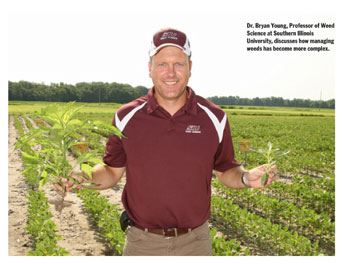Tank Mix Combinations Add Complexity
Avoid Tank Contamination
BELLEVILLE, ILL.
It is becoming more complex to manage weeds according to Dr. Bryan Young, Professor of Weed Science at Southern Illinois University. Glyphosate resistance in the Midwest, the southern corn-belt and specifically southern Illinois; and the resistance to other modes of action growers fall back on were discussed. “Some of those tools will be available in terms of herbicides like the PPO inhibiting herbicides, Cobra and FlexStar but in some cases they won’t be effective because we do have multiple herbicide resistance in water hemp.”
In terms of weed resistance, herbicides other than glyphosate must be considered. “Whether it is a soil applied herbicide or a post emergence herbicide tank mixed with glyphosate. We are finding these herbicides are necessary to get the level of weed control that growers expect, but we also need to keep crop tolerance to these herbicides in mind. Few herbicides are as safe as glyphosate applied in Roundup Ready crops. We are currently looking into soybean tolerance to some of the soil herbicide combinations that we’re using or may need to use in the future. In some cases we need as much residual as possible because we don’t have post emergence herbicides as an option due to multiple herbicide resistance.”
Young explained some companies have not tested some of these combinations. “It used to be cost prohibitive to do so in terms of grower cost per acre, or they wanted to really just market their own herbicides; not team up with another company and develop a program around their core products.”

Dr. Bryan Young, Professor of Weed Science at Southern
Illinois University,
discusses how managing weeds has become more
complex.
Young expects this to change. “I think it’s in our future, looking at these different combinations to get as much residual control as possible for something like water hemp. We have to know how these will perform for weed control, but also know if there is any increased risk for crop injury with the same true for post emergence herbicides. We used to talk a lot about the yellow flash in Roundup Ready acres with the use of glyphosate and on the non-GMO acres we had the burn from the PPO herbicides. Now we’re seeing that in the same soybean field. We’re seeing the leaves that are burnt from the foliar herbicides like Cobra and FlexStar as well as yellow flash about three days later from the glyphosate. Do higher rates of these herbicides in combination have a greater risk for any yield penalty? Especially as we use higher rates of Roundup or glyphosate because it is so cheap.”
“What we do know is that post-emergence herbicide applications in soybean have a higher risk to cause a yield reduction when applied to soybean in later growth stages and under a shorter growing season. Research has shown a lower risk for yield-limiting herbicide injury when applied to the early soybean growth stages, less than V5, over a relatively longer growing season. The early post-emergence herbicide application along with a longer season allows the soybeans a longer period of time to recover from any potential herbicide injury and do so early in the summer before the heat and drought stress in late summer.”
“As we have integrated additional herbicides into the Roundup Ready system we also need to pay close attention to sprayer hygiene,” said Young. Rinsing your tank may not be enough. “If you look at herbicide labels, they don’t recommend to just rinse the tank. The label suggests cleaning your tank. There’s a difference. Cleaning your tank requires some sort of detergent, whether it is ammonia, bleach, or a commercial tank cleaner product, so just rinsing your tank is like rinsing your hands. They are not clean. We need to remove, some of these other herbicides that we’re now integrating into our weed management program, out of our tank and make sure it is safe to go to the next field. Whether we are switching from corn to beans or from a pre or post application, we need to actually clean the tank to be more effective at doing so and reduce the risk of any tank contamination sacrificing our next crop.”
Young also suggests growers consider the size of the weeds at application. “A two inch weed is a lot easier to kill than an eight inch weed. And why do you want to do that? Well it’s getting more difficult to kill weeds so we might as well do it when we have the best chance of doing so, the smaller weeds. Be mindful of the weed competition and best agronomic practices to remove the weed competition. Make sure the nutrients you’re applying to your field are being used by the crop and not the weed.”
“Make sure we’re controlling the weeds at the right time,” said Young. “Our confidence in controlling weeds over six inches has diminished, so we need to be more diligent today in terms of getting those weeds under control early. It is a more complex system. You need to have as much education as possible to manage some of today’s most problematic weeds and continue research to make sure we’re making good decisions in the future.” Δ
REGINA LAROSE: Associate Editor, MidAmerica Farmer Grower